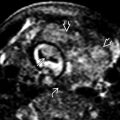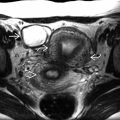KEY FACTS
Terminology
- •
Syndrome composed of classic triad of findings
- ○
Renal cystic dysplasia in 95-100%
- ○
Encephalocele or other central nervous system (CNS) abnormality in 90%
- ○
Postaxial polydactyly in 55-75%
- ○
- •
Should have at least 2 of 3 classic features
Imaging
- •
Renal cystic dysplasia most consistent finding
- ○
Kidney appearance is variable
- –
Most commonly grossly enlarged and echogenic but may be filled with macroscopic cysts
- –
- ○
Renal size often massive, causing enlarged abdominal circumference
- ○
- •
Occipital encephalocele classic CNS finding (60-80%) but may have other malformations
- ○
Dandy-Walker malformation, microcephaly, holoprosencephaly, anencephaly
- ○
- •
Diagnosis can be made in 1st trimester
- •
Severe oligohydramnios or anhydramnios by 2nd trimester
- ○
Makes evaluation of polydactyly and other more subtle findings difficult
- ○
Top Differential Diagnoses
- •
Trisomy 13: Significant overlap in imaging features
Clinical Issues
- •
Oligohydramnios leads to pulmonary hypoplasia
- ○
Most stillborn or die within few hours
- ○
- •
Autosomal recessive with 25% recurrence risk for future pregnancies
Scanning Tips
- •
May first present with increased nuchal translucency
- ○
Use endovaginal US to search for anomalies if suspicious findings or positive family history
- ○
- •
When 1 finding seen (especially enlarged kidneys), carefully search for others
 with a large encephalocele
with a large encephalocele  in a fetus with Meckel-Gruber syndrome. There is also oligohydramnios secondary to renal dysplasia.
in a fetus with Meckel-Gruber syndrome. There is also oligohydramnios secondary to renal dysplasia.










